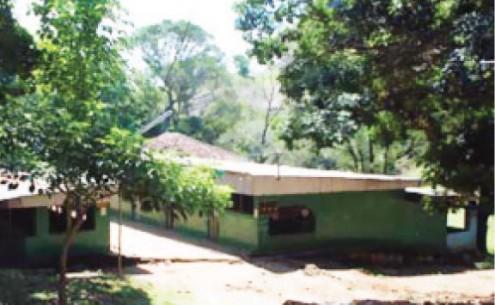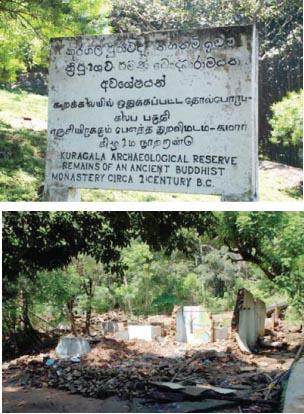Camelia Nathaniel
Source - http://www.thesundayleader.lk/2013/06/02/kuragala-buddhist-sacred-site-or-sufi-shrine/

While Muslims in Sri Lanka claim that Kuragala in the central hills of Sri Lanka near Balangoda in the Sabaragamuwa Province has been a holy mountain and is home to an ancient Sufi shrine sacred to Muslims, the Buddhists in the country claim that the rock cave is an ancient Buddhist monastic site.
The shrine at Jailani has also placed the Sri Lankan Muslims in a potential geo-religious conflict with Sinhala Buddhist majority. While the hard-line Buddhists are demanding the site be cleared of all Islamic buildings and monuments, the Muslims on the other hand are adamant that the mosque remain in its current location because it holds great significance for Muslims all over the island. Unless the issue is solved amicably, it could further aggravate tensions between the Buddhist and Muslim communities in the country.
The Muslims believe Arabic rock inscriptions, tombstones at the site and other historical evidences point to a greatly revered Islamic saint who had come on a pilgrimage to Adam’s Peak and meditated in the rock caves for 12 years.
However the Buddhists say archaeological evidences prove Kuragala indeed bears great significance to Buddhists.
Historical evidences

Explaining the historical relevance the site holds for the Buddhists, the Chief Incumbent of the temple Venerable Asgiri Maha Viharaye Karmacharya Poojya Panditha Dilthota Dhammajothi Thero told The Sunday Leader that Kuragala dates back to the King Ravana’s reign.
“Artefacts discovered from the site have further fortified our claims that these objects are over a thousand years old.
Most significant are the channels engraved beneath the drip ledges to flow water from the top (‘Katarama’; in Sinhalese) dating back over a thousand years.
Here you can find ample evidence to prove that this temple has been blessed by the saintly monks who spent their time in meditation.
Archaeology Department is excavating near the caves and its surroundings. Buddhist history of Kuragala dates back to 2300 BP, (2nd century BC) according to the rock inscriptions over the Kuragala caves.
Buddhist monks had always preferred dwelling in isolated mountain caves from where they could have enchanting vistas. Prof. Paranavitana had read three inscriptions of the site. Excavations have only been done in a small area up to now, and by considering the number of artefacts recovered, it is certain more extensive excavations will certainly unearth many more ancient artefacts,” he said.
Bellanbendi Palassa from where the Balangoda Man (Homo sapiens balangodensis) was discovered is very close to Kuragala.
Since the tribes of Balangoda Man had been living on Maha Eliya (now known as Horton Plains), they would have occupied the numerous caves found at Kuragala too.
Religious practices
The prehistoric humans too would have had their own religious practices that they would have observed on this mountain. King Ravana, the tribes Yaksha and Naga would have been the next occupants of Kuragala, giving rise to the legends that the Kurugala is Ravana’s Indragiri mountain.
Ven. Dhammajothi Thero further stated that this isolated area was renowned for ganja cultivation. It is said that a group of Muslims at the time had requested the village chieftain to grant them a piece of land for cultivating ganja. “Since the area was covered in thick jungle, the chieftain had given them this area and they had then discovered the caves and occupied them to guard their crops.
These Muslim folk probably had begun praying in caves according to their religion which require Muslims to pray several times a day irrespective of their location at the praying times. Later, to conduct their religious activities they had leased a small area on the Kuragala rock and built a mosque with the assistance of the politically influential Abusalley family.
Although females are not permitted to enter mosques, Kuragala mosque had been established as a place where females too could worship.
Furthermore, although the Muslims strictly forbid worshiping tombs, they have discarded the practice and worship several tombs today.
It is said that these occupants had damaged and destroyed several ancient Buddhist Chaithyas and other important religious artefacts.
They had then gradually transformed even the caves into Muslim places of worship and have earned millions through donations etc.
Jailani today attracts a large number of Muslim devotees to its annual kandoori festival and during the festival hundreds of cattle are slaughtered.
Great monk
However Ven. Wadassara Gnaneshwara Thero has been restoring the Buddhist heritage of the Kuragala mountain area since 1970.
“It was after this great monk had established a Buddhist statue at Kuragala, the Archaeology Department took interest in the ancient artefacts that were discovered and commenced excavations. Meanwhile the Muslims in the historical area had requested an alternate plot of land to relocate their mosque, and the late R. Premadasa had given them 28 acres. Even though they had accepted the land they never relocated the mosque. Even today Lady Abusalley occupies this land.
These Muslims have not spared a single Buddhist statue or artefact completely destroying them. Of the six rock inscriptions, many have been deliberately burnt and destroyed, which is a great shame,” Ven. Dhammajothi Thero added.
Jailani is said to have been a place of Muslim refuge and Sufi meditation since the beginning of the 4th century of the Islamic era. A dervish tombstone and some Arabic inscriptions discovered at the sites would seem to support this view.
However, the present infrastructures of the Jailani shrine are of 20th century origin.
Muslims say that they have been visiting this site since ancient times to rest on their way to Adam’s Peak in South of Sri Lanka and then began treating it as a holy site of Islam’s greatest saints, Sheikh Mohiyadeen Abdul Qadir Gilani who meditated on a ledge here accessible through a cave known as ‘SorangaMalai’ or the ‘Mountain of the Cave’. According to present trustee of Jailany, Roshana Aboosally this site was handed over to the Archaeology Department in 1972 by a cabinet order.
The department erected a signboard stating that this site was an ancient Buddhist monastery. It also issued a notice stating that the Muslims’ worshiping Kuragala will not be affected by any conservation work of the site.
“During a recent visit to Kuragala, the Defence Secretary has stated all extraneous buildings in the site should be removed for conservation work although the buildings were there before the handing over of the site to the Archaeology Department.
He has directed the Director General of the Archaeological Department to form a committee comprising officials of the department, the trustees of the mosque and the Maha Sangha to reach an amicable settlement on the removal of the buildings.
The Defence Secretary has assured the Muslims the mosque built in 1922 will not be affected, and the Director General too emphasise that the mosque will not be harmed under any circumstance and that the Muslims can conduct religious observances as they have been doing in the past,” she said.
On the advice of an environmental architect, the trustees of the Masjid have sought the services of a surveyor to conduct a contour survey of the 26 acres outside the archaeological site.
Defence Secretary’s directive
“We informed the Defence Secretary and the Director General that we had commenced work and that we would begin construction in the new location when the architect submits the building plans and the cost estimates.
The Defence Secretary generously offered to help find funding, and we hope to commence work in July/August 2013.
Regretfully, contrary to the directive given by the Defence Secretary, the Director General on the advice of his legal team commenced demolishing the buildings by employing about 50 youth under the Civil Defence Forces without prior notice to the trustees of the mosque,” she added.
She observed that the Archaeology Department may have the authority to clear the site for conservation purposes.
“However, proper procedure should have been followed allowing reasonable time frame for relocation. I urge the Director General to kindly temporarily suspend the dismantling of the few remaining buildings and commence conservation work in already cleared areas.”
The Director General had informed the trustees that the bones of a prehistoric human had been found during their recent excavation, and this site is of immense archaeologicalsignificance. “Since it has been declared as an archaeological site and no one can build on this site, I believe that both parties need to cooperate and the whole issue should be settled amicably without any disrespect or harm to either faith.
I, on behalf of the trustees, would kindly appeal to the leaders of the nation, the Sangha, the open minded and tolerant citizens to find a peaceful solution through discussion and consensus.
“I would also like to appeal to the Sangha and people of Balangoda, an electorate with 97% Sinhalese.
They elected a Muslim to represent them in Parliament and he served the electorate humbly for 17 years.
We withstood together all the problems that our Country has endured without any divisions of caste, creed, ethnicity, religion and even politics. Therefore I appeal everyone to safeguard the peace in Balangoda and our beloved country,” Roshana said.
While well documented evidences indicate that the entire Kuragala surrounds the Buddhist Stupa belonged to a historical Buddhist archaeological site, everyone involved must take extreme care safeguarding national interest not to arouse religious or ethnic sentiments that could once again plunge this country into conflict.
For some transition is difficult, they need help, not sarcasm. If Kuragala is to be restored as a Buddhist archaeological site, it is imperative to carry out this meritorious act amicably disregarding mindless competition and conflict.